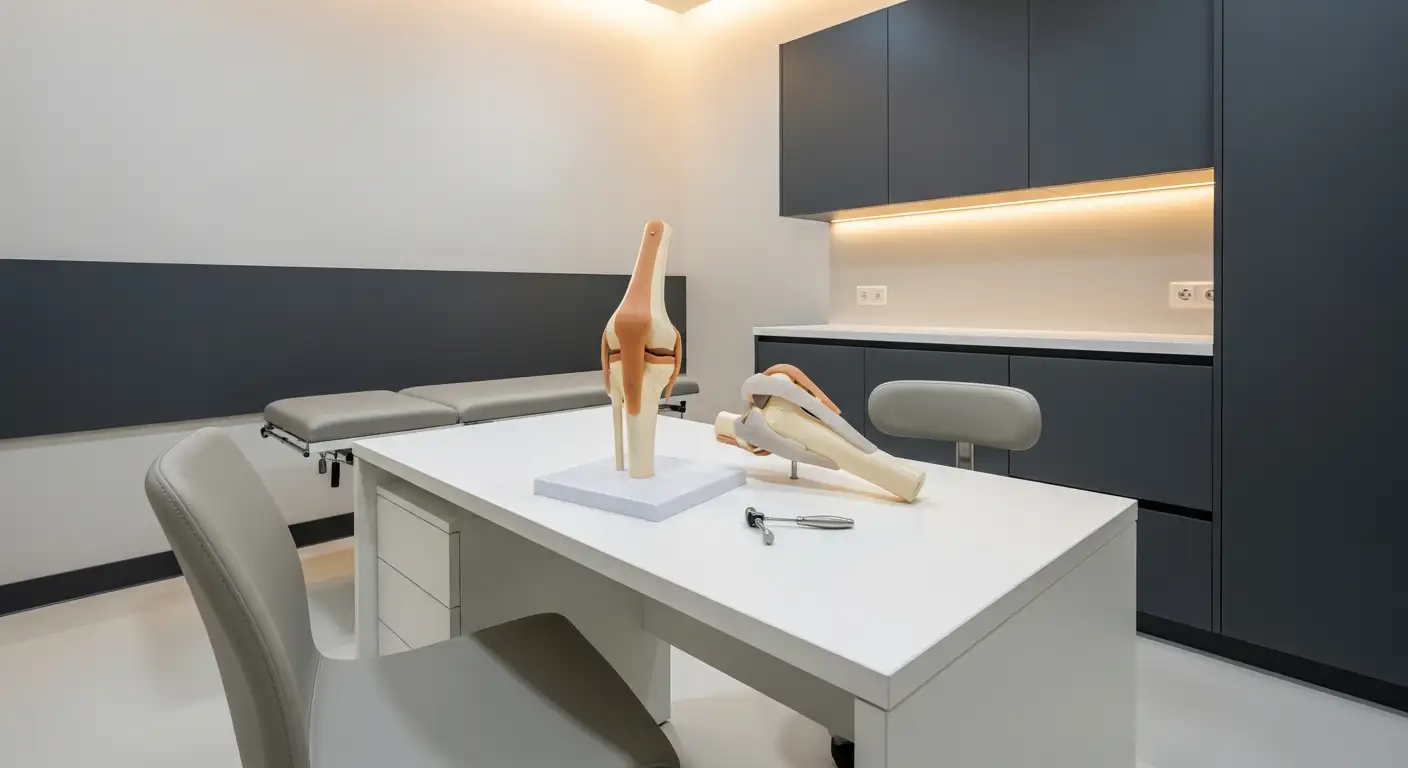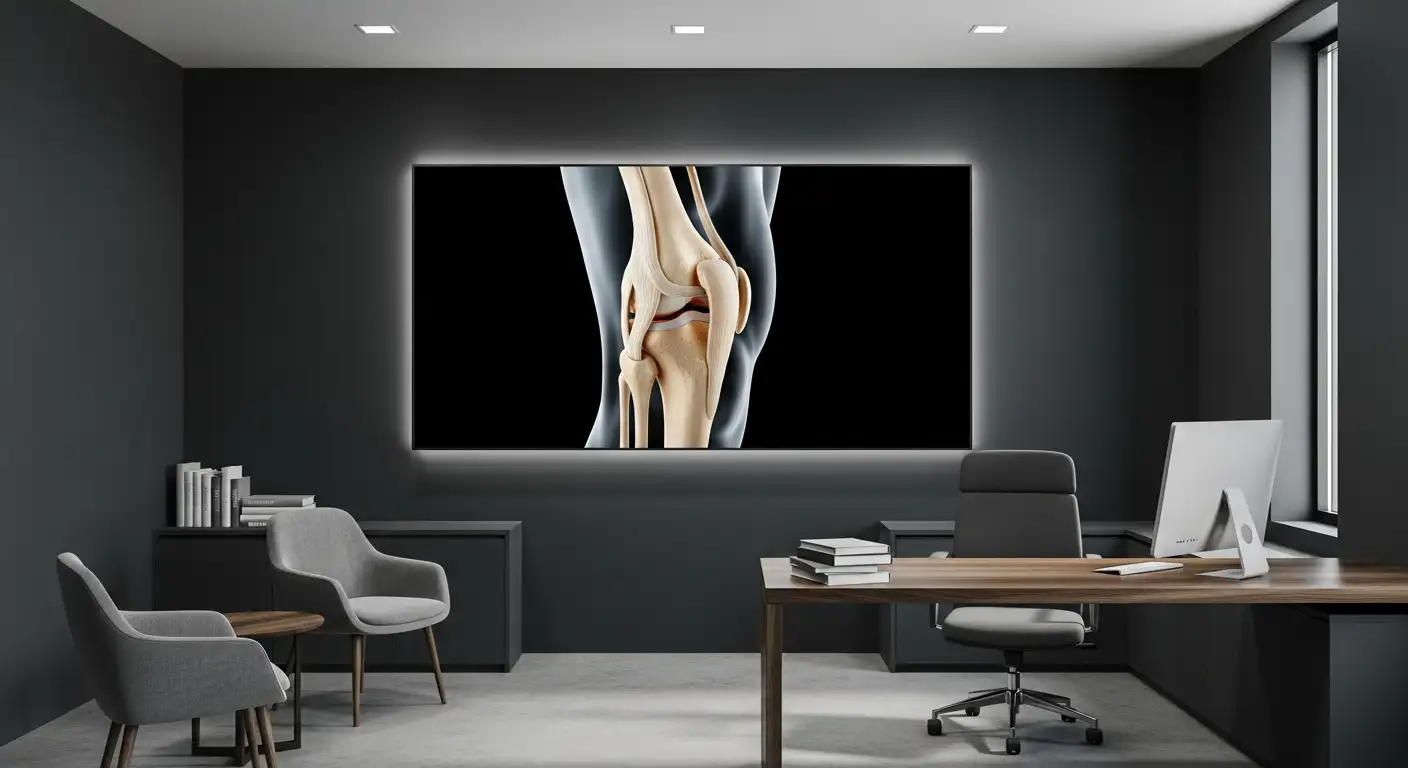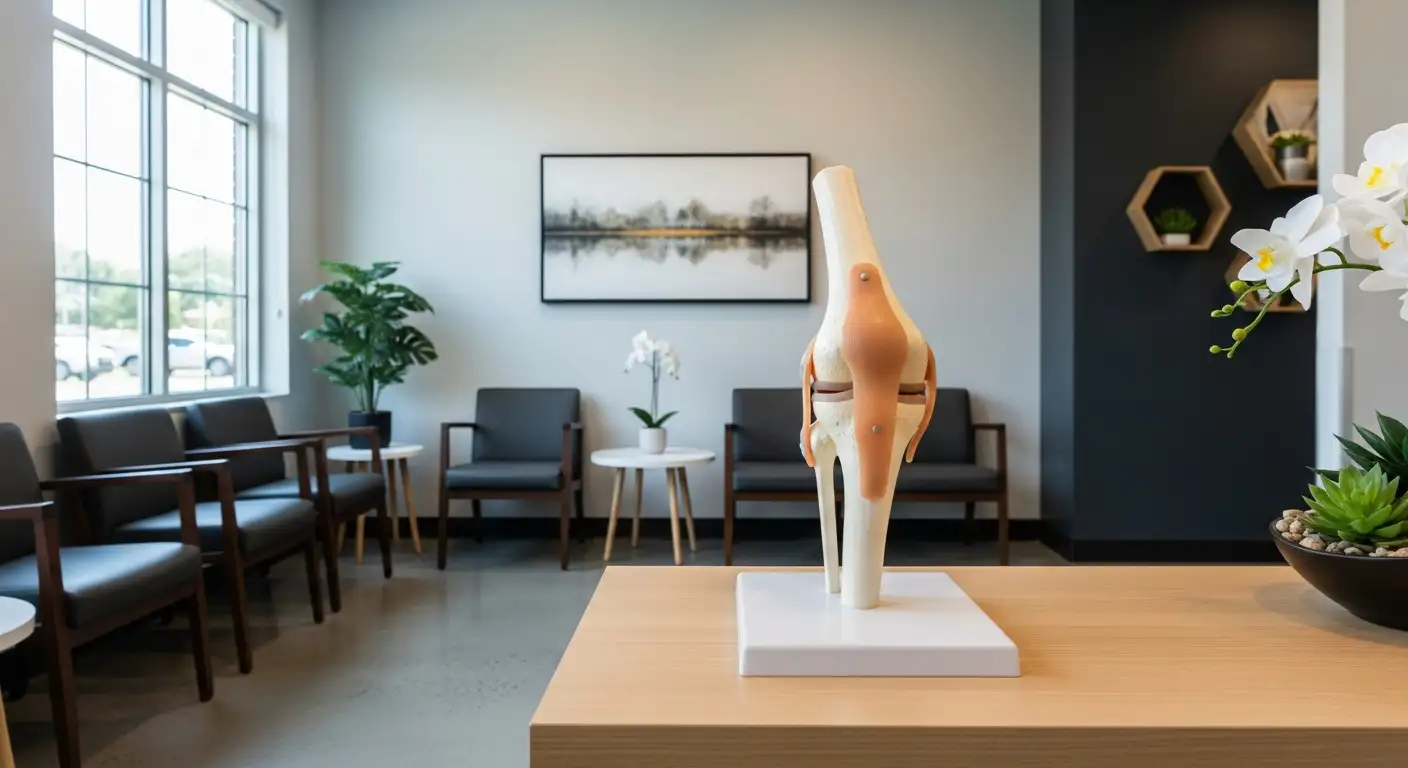Understanding Knee Pain
Knee pain is a common complaint that can stem from various causes and conditions. Understanding these factors is crucial for effective management.

Causes of Knee Pain
Knee pain can arise from different underlying issues. One prevalent cause is chondromalacia, a condition where the cartilage beneath the kneecap softens and deteriorates. This results in pain, especially noticeable when climbing stairs, due to the excessive movement of the kneecap sliding over the femur [1]. Other causes include injuries like a torn meniscus, patellofemoral pain syndrome, or conditions related to overuse.
Risk factors for knee pain often involve activities that put strain on the knees. For example, frequent stair climbing, running, squatting, or sitting with bent knees can exacerbate the discomfort. Weakness in thigh or calf muscles can also lead to misalignment and contribute to knee pain [1].
CauseDescriptionChondromalaciaSoftening and wear of cartilage under the kneecap, causing pain during climbing or deeper movements.Torn MeniscusInjury to the cartilage in the knee, leading to pain and instability.Patellofemoral Pain SyndromePain arising from issues in the kneecap, often during activities involving bending.
Common Symptoms
Individuals experiencing knee pain may observe various symptoms, which can include:
It is critical for those experiencing these symptoms to seek understanding of their specific situation and consider appropriate preventive measures or treatments. For more insights on managing knee pain during daily activities, explore our section on lifestyle modifications.
Specific Conditions Related to Knee Pain
Understanding specific conditions that contribute to knee pain is essential for effective management and treatment. Three common conditions related to knee pain when walking up stairs are chondromalacia, patellofemoral pain syndrome, and a torn meniscus.
Chondromalacia and Knee Pain
Chondromalacia is a condition where the cartilage under the kneecap softens and wears away. This often leads to knee pain, particularly when climbing stairs. The discomfort arises because the kneecap slides up and down over the femur more than usual during deeper movements like stair climbing, resulting in pain during these actions.
SymptomDescriptionPain LocationFront of the knee, particularly during stair climbingDurationPain may be intermittent or intense during specific activitiesAggravating FactorsClimbing stairs, squatting, sitting for long periods
Patellofemoral Pain Syndrome
Patellofemoral Pain Syndrome (PFPS) can also lead to significant discomfort when going up stairs. This condition is characterized by a dull, aching pain in the front of the kneecap. Common symptoms associated with PFPS include:
These symptoms often intensify when engaging in stair climbing or prolonged sitting.
SymptomDescriptionPain TypeDull, aching pain in the front of the kneecapActivities AffectedWalking, running, climbing stairsAdditional SymptomsTenderness, swelling, discomfort when bending the knee
Torn Meniscus
A torn meniscus is another possible contributor to knee pain experienced when ascending stairs. This injury occurs when a tear develops in the cartilage that serves as a cushion between the bones in the knee. Symptoms typically include:
If there is suspicion of a meniscus tear, it is crucial to consult a healthcare provider for a proper diagnosis and treatment [3].
SymptomDescriptionPain LocationInside or outside of the kneeSpecific SymptomsStiffness, swelling, catching or locking sensationsInstabilityFeeling of knee giving out
Recognizing these conditions can aid in effective management for those experiencing knee pain when walking up stairs. Understanding the specific symptoms associated with each condition allows for better prevention and treatment strategies. For additional insights about different knee-related issues, explore articles related to tight hamstrings and knee pain or my knee feels weird but doesn’t hurt.
Risk Factors and Prevention
Knee pain is a common issue that many individuals face, especially when engaging in activities like walking up stairs. Understanding the risk factors and implementing preventive measures can significantly contribute to knee health.
Factors Influencing Knee Pain
Several factors can increase the likelihood of experiencing knee pain when walking up stairs. These include:
Risk FactorDescriptionAgeAs people age, the cartilage in their knees can wear down, making them more susceptible to pain.WeightExcess body weight puts additional stress on the knees, especially during activities like stair climbing.Activity LevelEngaging in high-impact sports or activities, like running and jumping, can contribute to conditions such as chondromalacia, often referred to as "runner's knee." Individuals who sit for long periods with their knees flexed may also experience increased pain.Muscle ImbalanceWeak quadriceps or tight hamstrings can strain the knee joint and lead to discomfort.Previous InjuriesA history of knee injuries can affect the stability and functionality of the knee.StiffnessLimited range of motion can make activities requiring knee bending, such as climbing stairs, more painful.
For individuals experiencing knee pain or symptoms associated with chondromalacia, early treatment is crucial to prevent further damage to the cartilage and alleviate discomfort.
Preventive Measures
There are several strategies one can adopt to help prevent knee pain when navigating stairs:
By understanding these risk factors and incorporating preventive measures, individuals can help maintain knee health and minimize the risk of injuries or pain associated with activities like walking up stairs.
Diagnosis and Treatment Options
Identifying the Underlying Cause
Knee pain when walking up stairs can arise from several underlying conditions. A thorough diagnosis is essential to understand the specific cause of the pain. Conditions such as chondromalacia, patellofemoral pain syndrome, and torn meniscus are common contributors.
Chondromalacia, often referred to as "runner's knee," occurs when the cartilage under the kneecap softens and wears away. This condition frequently results in pain during activities that involve bending the knee deeply, such as climbing stairs [1]. Patients may also experience a cracking or grinding sensation after extensive activity.
Identifying the precise cause of knee pain typically requires a physical examination, imaging tests like X-rays or MRIs, and a discussion of the patient's activity levels and symptoms. Risk factors such as muscle imbalances, excessive knee use, and certain physical activities (like running or cycling) are also considered during the diagnosis.
Treatment Strategies
Once the underlying cause of knee pain is identified, several treatment strategies can be used to alleviate discomfort. Here's a table summarizing potential treatment options:
Treatment StrategyDescriptionLifestyle RemediesEngage in low-impact exercises like walking and swimming. Avoid activities that induce pain.Pain Relief MedicationOver-the-counter medications such as NSAIDs may be used to manage pain and inflammation.OrthoticsCustom shoe inserts can help restore proper alignment and reduce stress on the knee.Physical TherapyExercises to strengthen thigh and calf muscles can improve stability and reduce pain.Knee Support StrapsUsing knee straps may provide support and relieve discomfort during activities.
Implementing a balanced approach that includes low-impact exercises, maintaining a healthy diet, and ensuring adequate rest can greatly assist in managing knee pain. It is crucial to avoid any activities that worsen the discomfort and consult with a healthcare professional for personalized advice. For more information on related issues, visit our articles on tight hamstrings knee pain, torn calf recovery time, and my knee feels weird but doesn’t hurt.
Lifestyle Modifications for Knee Health
Knee health can significantly influence daily activities, particularly activities like climbing stairs. Making informed lifestyle modifications can help manage knee pain when walking up stairs and improve overall mobility.
Exercise and Strengthening
Incorporating targeted exercises into a daily routine can strengthen muscles surrounding the knee, thus alleviating pain and discomfort. Strengthening the quadriceps, hamstrings, and calf muscles supports knee stability and function. Below is a table listing recommended exercises and their targeted areas:
ExerciseTargeted MusclesSeated Glute StretchGlutesKneeling Hamstring StretchHamstringsQuadriceps StrengtheningQuadricepsCalf RaisesCalvesStep-UpsOverall leg muscles
Regular stair climbing can also serve as a beneficial exercise. It helps manage weight and burn calories, reducing pressure on the knees. Five minutes of stair climbing can burn approximately 45 calories. Over the course of 50 weeks, this could equate to burning about 11,250 calories, leading to weight loss of more than three pounds.
When starting a new exercise regimen, it's essential to begin gradually and increase intensity over time to avoid exacerbating knee pain.
Managing Knee Pain Daily
Daily management of knee pain can involve a combination of lifestyle adjustments and preventive measures. Here are some strategies that individuals can adopt:
For those experience further concerns, it may be beneficial to explore information on conditions affecting knee health such as tight hamstrings knee pain or quadriceps tendon tear symptoms.
By incorporating these exercises and strategies into daily routines, individuals can improve knee health and reduce discomfort associated with activities like stair climbing. Remember to listen to one's body and adjust activities as necessary to avoid further injury.
Surgical Interventions for Knee Pain
Knee pain can severely impact daily activities, and in some cases, surgical interventions may be required. Total knee replacement (TKR) is one such procedure that can alleviate chronic pain and restore function. However, challenges can arise post-surgery that may complicate recovery, particularly when it comes to activities like walking up stairs.
Total Knee Replacement (TKR)
Total knee replacement is commonly performed to correct end-stage knee osteoarthritis. The frequency of TKRs has been expected to double in the U.S., reaching nearly 3.5 million by 2030. This surgical procedure involves removing damaged cartilage and bone from the knee joint and replacing them with an artificial joint [5]. TKR can significantly reduce pain and improve mobility, but patients may still face difficulties, especially with stair climbing post-operatively.
During stair climbing, TKR patients often exhibit reduced peak knee extension moments when compared to healthy individuals. Instrumented studies have shown that compressive loads at the knee during stair ascent can be significant, ranging between 2.5 and 3.06 times the body weight of the individual [5]. These factors can pose challenges for recovering patients, as effective strength in the knee extensors becomes paramount for proper stair negotiation.
FactorTKR PatientsHealthy ControlsPeak Knee Joint ForceUp to 7 bodyweights in severe abnormalities2.8 bodyweightsCompressive Joint Reaction ForcesSimilar during loading responseN/AQuadriceps Muscle ForceDeficiencies observedOptimal strength
Post-Surgery Challenges
Post-surgical challenges can be substantial for TKR patients. During stair ascent, they may demonstrate deficiencies in quadriceps muscle force production. This could be due to ongoing impairments or compensatory strategies adopted during recovery [5]. Although the knee joint reaction forces during the loading response did not significantly differ between TKR patients and healthy individuals, TKR patients displayed reduced muscle force in the knee extensors.
Further complicating matters, TKR patients often compensate by utilizing greater flexor muscle forces, leading to a shift in muscle strategies during the push-off phase while climbing stairs. Continued muscle weakness or altered mechanics can hinder overall recovery, making everyday tasks like walking up stairs a persistent issue for many.
Addressing these challenges requires a comprehensive rehabilitation plan focusing on strength training and mobility exercises. Understanding these dynamics helps in setting realistic expectations for recovery and the importance of following through with post-operative rehabilitation programs. For individuals facing issues with tight hamstrings causing knee pain or who wish to learn about muscle stretches, resources like the seated glute stretch or kneeling hamstring stretch can be useful supplementary techniques.
References
[2]:
[3]:
[4]:
[5]:





